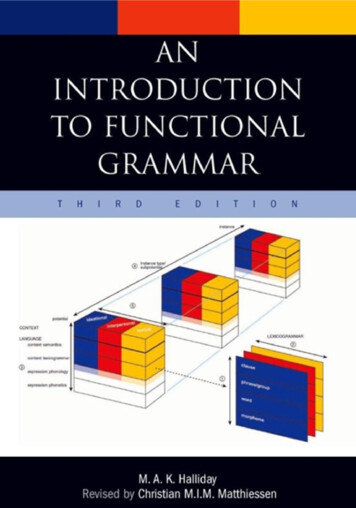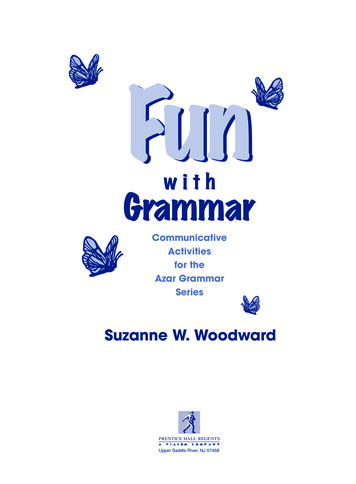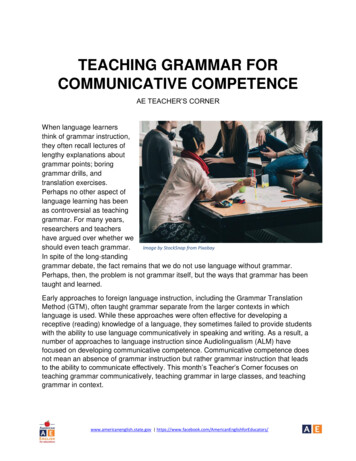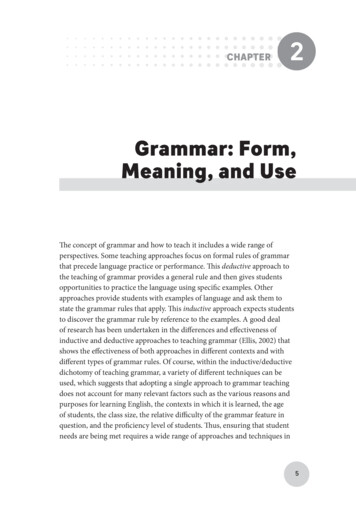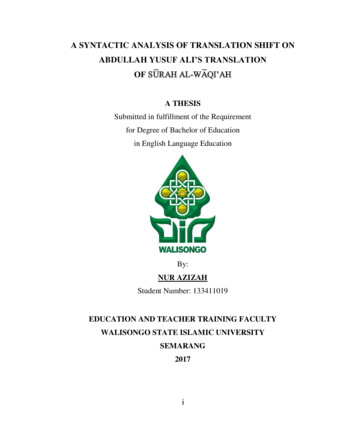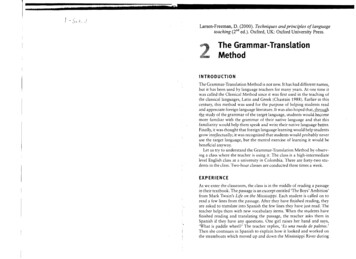
Transcription
1 -·i,Larsen-Freeman, D. (2000). Techniques and principles o/languageteaching (2 nd ed.). Oxford, UK: Oxford University Press.The Grammar-TranslationMethodINTRODUCTIONThe Grammar-Translation Method is not new. It has had different names,but it has been used by language teachers for many years. At one time itwas called the Classical Method since it was first used in the teaching ofthe classical languages, Latin and Greek (Chastain 1988). Earlier in thiscentury, this method was used for the purpose of helping students readand appreciate foreign language literature. It was also hoped that, throughthe study of the grammar of the target language, students wouldhec.omemore familiar with the grammar of their native language and that thisfamiliarity would help them speak and write their native language better.Finally, it was thought that foreign language learning would help studentsit was recognized that students would probably neveruse the target language, but the mental exercise of learning it would bebeneficial anyway.Let us try to understand t1H Grammar-Translation Method by observing a class where the teacher is using it. The class is a high-intermediatelevel English class at a university in Colombia. There are forty-two students in the class. Two-hour classes are conducted three times a week.EXPERIENCEAs we enter the classroom, the class is in the middle of reading a passagein their textbook. The passage is an excerpt entitled 'The Boys' Ambition'from Mark Twain's Life on the Mississippi. Each student is called on toread a few lines from the passage. After they have finished reading, theyare asked to translate into Spanish the few lines they have just read. Theteacher helps them with new vocabulary items. When the studentsfinished reading and translating the passage, the teacher asks them inSpanish if they have any questions. One girl raises her hand and says,'What is paddle wheel?' The teacher replies, 'Es una rueda de paletas.'Then she continues in Spanish to explain how it looked and worked onsteamboats which moved up and down the Mississippi River during
--------'" ; 12-- --S",,'II7The Grammar-Translation MethodMark Twain's childhood. Another student says, 'No understand "gorgeous.'" The teacher translates, 'Primoroso.'Since the students have no more questions, the teacher asks them towrite the answers to the comprehension questions which appear at theend of the excerpt. The questions are in English, and the students areinstructed to write the answers to them in English as well. They do thefirst one together as an example. A student reads out loud, 'When didMark Twain live?' Another student replies, 'Mark Twain lived from 1835to 1910.' 'Bueno; says the teacher, and the students begin working quietly by themselves.In addition to questions that ask for information contained within thereading passage, the students answer two other types of questions. Forthe first type, they have to make inferences based on their understandingof the passage. For example, onc question is: 'Do you think the boy wasambitious? Why or why not?' The other type of question requires the students to rclate the passage to their own experience. For example, onc ofthe questions based on this excerpt asks them, 'Have you ever thoughtabout running away from home?'After one-half hour, the teacher, speaking in Spanish, asks the studentsto stop and check their work. One by one each student reads a questionand then reads his or her response. If it is correct, the teacher calls onanother student to read the next question. If the answer is incorrect, theteacher selects a different student to supply the correct answer, or theteacher herself gives the right answer.Announcing the next activity, the teacher asks the students to turn thepage in their text. There is a list of words there. The introduction to theexercise tells the students that these are words taken from the passagethey have just read. The students see the words 'ambition,' 'career,''wharf,' 'tranquil,' 'gorgeous,' 'loathe,' 'envy,' and 'humbly.' They aretold that some of these are review words and that others are new to them.The students are instructed to give the Spanish word for each of them.This exercise the class does together. If no one knows the Spanish equivalent, the teacher gives it. In Part 2 of this exercise, the students are givenEnglish words like 'love,' 'noisy,' 'ugly,' and 'proudly,' and are directed tofind the opposites of these words in the passage.When they ha ve finished this exercise, the teacher reminds them thatEnglish words that look like Spanish words are called 'cognates.' TheEnglish '-ty,' she says for example, often corresponds to the Spanish endings -dad and -tad. She calls the students' attention to the word 'possibility' in the passage and tells them that this word is the same as the Spanishposibilidad. The teacher asks the students to find other examples inThe Grammar-Translation Method13.Exercise 2AThese words are taken from the passage you have justread. Some of them are review words and others are new.Give the Spanish translation for each of them. You mayrefer back to the reading nvyhumblyExercise 2BThese words all have antonyms in the reading passage.Find the antonym for each:lovenoisyuglyproudlyexcerpt. Hands go up; a boy answers, 'Obscurity.' 'Bien,' says the teacher.When all of these cognates from the passage have been identified, the students are told to turn to the next exercise in the chapter and to answer thequestion, 'What do these cognates mean?' There is a long list of Englishwords ('curiosity,' 'opportunity,' 'liberty,' etc.), which the students translate into Spanish.The next section of the chapter deals with grammar. The students follow in their books as the teacher reads a description of two-word orphrasal verbs. This is a review for them as they have encountered phrasalverbs before. Nevertheless, there are some new two-word verbs in thepassage the students haven't learned yet. These arc listed following thedescription, and the students are asked to translate them into Spanish. Thenthey are given the rule for use of a direct object with two-word verbs:If the two-word verb is separable, the direct object may come betweenthe verb and its particle. However, separation is necessary when thedirect object is a pronoun. If the verb is inseparable, then there is noseparation of the verb and particle by the object. For example:John put away his book.orJohn put his book away/John put it away.
14The Grammar-Translation MethodThe Grammar- Translation Methodbut notdrinksingsWImringbeginJohn put away it.(because 'put away' is a separablNwo-word verb)The teacher went over the homework.but notThe teacher went the homework over.(because 'go over' is an inseparable two-word verb).wake upfade outbreakdownget onlay upturn back6 Take a quiz on the grammar and vocabulary of this chapter. Theybe asked to translate a Spanish paragraph about steamboats intoEnglish.THINKING ABOUT THE EXPERIENCEtake inFinally, they are asked to put one of these phrasal verbs in the blank ofeach of the ten sentences they are given. They do the first two together.,"1 Mark Twain decided to because his parents wouldn't let himget a job on the river.2 The steamboatmen and discharge freight at each port on theMississippi River.When the students are finished with this exercise, they read their answersaloud.At the end of the chapter there is,a list of vocabulary items thatappeared in the passage. The list is divided into two parts: the first contains words, and the second, idioms like 'to give someone the cold shoulder.' Next to each is a Spanish word or phrase. For homework, theteacher asks the students to memorize the Spanish translation for the firsttwenty words and to write a sentence in English using each word.In the two remaining lessons this week, the students will be asked to:1 Write out the translation of the reading passage into Spanish.2 State the rule for the use of a direct object with two-word verbs, andapply it to other phrasal verbs.3 Do the remaining exercises in the chapter that include practice withone set of irregular past participle forms. The students will be asked tomemorize the present tense, past tense, and past pa'rticiple forms of thisirregular paradigm:drunksungswumrungbegun4 Write a composition in the target language about an ambition they have.S Memorize the remaining vocabulary items and write sentences foreach.After reading over the rule and the examples, the students are asked to tellwhich of the following two-word verbs, taken from the passage, are separable and which inseparable. They refer to the passage for clues. If theycannot tell from the passage, they use their dictionaries or ask theirteacher.turn uprun awaygo awaydranksangswamrangbegan15This has been just a brief introduction to the Grammar-TranslationMethod, but it is probably true that this method is not new to many ofYOll. You may have studied a language in this way, or you may be teachingwith this method right now. Whether this is true or not,Jet us see whatwe have learned abourrhe Grammar-Translation Method. We are able tomake a number of observations about the class we attended. Our observations will be listed in the left column; from them we will try to identifythe principles of the Grammar-Translation Method. The principles willbe listed in the right column. We will make our observations in order,lowing the lesson plan of the class we observed.Observations1 The class is reading an excerptfrom Mark Twain's Life on theMississippi.2 Students translate the passagefrom English to Spanish.PrinciplesA fundamental purpose oflearning a foreign language is to beable to read literature written in it.Literary language is superior tospoken language. Students' studyof the target culture is limited to itsliterature and fine arts.An important goal is for studentsto be able to translate eachlanguage into the other. If studentscan translate from one languageinto another, they are consideredsuccessful language learners.
).:1.111116IIThe Grammar-Translation MethodObservations.-Principles3 The teacher asks students intheir native language if theyhave any questions. A studentasks one and is answered inher native language.The ability to communicate in thetarget language is not a goalforeign language instruction.4 Students write out the answers. to reading comprehensionquestions.The primary skills to be developedare reading and writing .attention is given-to speaking andlistening, and almost none topronunciation.5 The teacher decides whetheran answer is correct or not. Ifthe answer is incorrect,teacher selects a differentstudent tosupply the correctanswer or the teacher herselfgives the right answer.The teacher is the authority in theclassroom. It is very importantthat students get the correctanswer.6 Students translate new wordsfrom English into Spanish.It is possible to find nativelanguage equivalents for all targetlanguage words.7 Students learn that English'-ty' corresponds to -dad and-tad in Spanish.Learning is facilitated throughattention to similarities betweenthe target language and the nativelanguage.8 Students are given a grammarrule for the use of a directobject with two-word verbs.It is important for students tolearn about the form of the targetlanguage.9 Students apply a rule toexamples they are given.Deductive application of anexplicit grammar rule is a usefulpedagogical technique.10 Students memorizevocabulary.Language learning provides goodmental exercise.The Grammar-Translation MethodObservations17Principles11 The teacher asks students tostate the grammar rule.Students should be conscious ofgrammatical rules of the targetlanguage.12 Students memorize presenttense, past tense, and pastparticiple forms of one set ofirregular verbs.Wherever possible, verbconjugations and othergrammatical paradigms should becommitted to memory.There were other activities planned for the remainder of the week, but inbook we will follow the practice of not listing an observation unless itleads to our discovering a different principle of the method.REVIEWING THE PRINCIPLESThe principles of the Grammar-Translation Method are organized belowby answering the ten questions posed in Chapter 1 (pages 7-8). Not allthe questions are addressed by the Grammar-Translation Method; wewi1llist all the questions, however, so that a comparison among the methods we will study will b.e ea er for you to make.1 What are the goals of teachers who use the Grammar-TranslationMethod?According to the teachers who use the Grammar-Translation Method,a fundamental purpose of learning a foreign language is to be ableto read literature written in the target language. To do this, studentsneed to learn about the grammar rules and vocabulary of the targetlanguage. In addition, it is believed that studying a foreign languageprovides students with good mental exercise which helps develop theirminds.2 What is the role of the teacher? What is the role of the students?The roles are very traditional. The teacher is the authority in the classroom. The students do as she says so they can learn what she knows.3 What are some characteristics of the teaching/learning process?Students are taught to translate from one language to another. Oftenwhat they translate are readings in the target language about some
18The Grammar-Translation Methodaspect of the culture of the target language community. Students studygrammar deductively; that is, they are given the grammar rules andexamples, are told to memorize them, and then are asked to apply therules to other examples. They also learn grammatical paradigms suchas verb conjugations. They memorize native-language equivalents fortarget-language vocabulary words.4 What is the nature of student-teacher interaction? What Is the natureof student-student Interaction?Most of the interaction in the classroom is from the teacher to the students. There is little student initiation and little student-student interaction.5 How are the feelings of the students dealt with?There are no principles of the method which relate to this area.6 How is the language viewed? How is culture viewed?Literary language is considered superior to spoken language and· istherefore the language that students study. Culture is viewed as coo ,sisting of literature and the fine arts.7 What areas of language are emphasized? What language skills areemphasized?Vocabulary and grammar are emphasized. Reading and writing are theprimary skills that the students work on. There is much less attentiongiven to speaking and listening. Pronunciation receives little, if any attention.8 What is the role of the students' native language?The meaning of the target language is made clear by translating it intothe students' native language. The language that is used in class ismostly the students' native language.9 How is evaluation accomplished?Written tests in which students are asked to translate from their nativelanguage to the target language or vice versa are often used. Questionsabout the target culture or questions that ask students to apply grammar rules are also common.The Grammar-Translation Method1910 How does the teacher respond to student errors?Having the students get the correct answer is considered very important. If students make errors or do not know an answer, the teachersupplies them with the correct answer.REVIEWING THE TECHNIQUESAsk yourself if any of the answers to the above questions make sense toyou. If so, you may choose to try some of the techniques of the GrammarTranslation Method from the review that follows. On the other hand,you may find that you agree very little with the answers to these questions, but that there are still some useful techniques associated with theGrammar-Translation Method. Below is an expanded description ofsome. of these techniques.Translation of a literary passageStudents translate a. reading passage from the target language into theirnative language. The reading passage then provides the focus for several. classes: vocabulary and grammatical s!ructures in the passage are studiedin subsequent lessons. The passage may be excerpted from some workfrom the target language literature, or a teacher may write a passage carefully designed to include particular grammar rules and vocabulary. Thetranslation may be written or spoken or both. Students should not translate idioms and the like literally, but rather in a way that shows that theyunderstand their meaning.Reading comprehension questionsStudents answer questions in the target language based on their understanding of the reading passage. Often the questions are sequenced so thatthe first group of questions asks for information contained within the reading passage. In order to answer the second group of questions, students willhave to make inferences based on their understanding of the passage.Thismeans they will have to answer questions about the passage even though he answers are not contained in the passage itself. The third group ofquestions requires students to relate the passage to their own experience.Antonyms/synonymsStudents are given one set of words and are asked to find antonyms in thereading passage. A similar exercise could be done by asking students to
I20The Grammar-Translation MethodThe Grammar-Translation Methoda partiCUlar set of words. Or students might be askeda set at words based on their understanding of them as theyoccur in the reading passage. Other exercises that ask students to workwith the vocabulary of the passage are also possible.CognatesStudents are taught to recognize cognates by learning the spelling orsound patterns that correspond between the languages. Students are alsoasked to memorize words that look like cognates but have meanings inthe target language that are different from those in the native language.This technique, of course, would only be useful in languagescognates.Deductive application of ruleGrammar rules are presented with examples. Exceptions to each rule arealso noted. Once students understand a rule, they are asked to apply it tosome different examples.FiU-in-the-blanksStudents are given a series of sentences with words missing. They fill inthe blanks with new vocabulary items or with items of a particular grammar type, such as prepositions or verbs with different tenses.Memorizationlanguage vocabulary words and theirare asked to memorize them. Studentsto memorize grammatical rules and grammatical paraconjugations.Use words in sentencesIn order to show that students understand the meaning and use-of a newvocabulary item, they make up sentences in which they use the new words.CompositionThe teacher gives the students a topic to write about in the targetguage. The topic is based upon some aspect of the reading passage of thelesson. Sometimes, instead of creating a comoosition, students are askedto prepare a precis of the reading passage.21CONCLUSIONYou have now had an opportunity to examine the principles and some ofthe techniques of the Grammar-Translation Method. Try to make a connection between what you have understood and your own teaching situation and beliefs.Do you believe that a fundamental reason for learning aguage is to be able to read the literature written in the targetyou think it is important to learn about the target language? Should culture be viewed as consisting of literature and the fine arts? Do you agreethe other principles underlying the Grammar-TranslationWhich ones?Is translation a valuable exercise? Is answering reading comprehensionquestions of the type described here helpful? Should grammar be presented deductively? Are these or any of the other techniques of theGrammar-Translation Method ones which will be useful to you in yourown teaching? Which ones?ACTIVITIESA Check your understanding of the Grammar-Translation Method.1 It has been said that the Grammar-Translation Method teaches stutarget language, but not how to use it. Explain the difTPrpn,"p in your own words.2 What are the clues that this method had its origin in the teaching of theclassical languages, Latin and Greek?B Apply what you have understood about the Grammar-TranslationMethod.1 Think of a particular group of students youcurrently teaching. Choose a reading passage trom a literary work or atextbook or write one yourself. Make sure it is at a level your studentsyet not at a level that would be too simple forall: lallIlg it yourself as a test of its difficulty. Identify the vocabuyou would choose to work on. Plan vocabulary exercises youwould use to help your students associate the new words with theirnative language equivalents.2 Pick a grammatical point or two contained in the same pa sage.Provide the explicit grammar rule that relates to each one ana give
-:::.4':5' , 'A 22The Grammar-Translation Methodsome examples. Design exercises that require your students to applythe rule to some different examples.REFERENCES AND ADDITIONAL RESOURCESChastain, Kenneth. 1988. Developing Second Language Skills. (3rdedn.)San Diego, CA: Harcourt Brace Jovanovich.Coleman, A. 1929. The Teaching of Modern Foreign Languages in theUnited States. Vol. 12. American and Canadian Committees onModern Languages.Howatt, A. P. R. 1984. A History of English Language Teaching. Oxford:Oxford University Press.Kelly, Louis G. 1969. Twenty-five Centuries of Language Teaching.Rowley, MA: Newbury House.Plotz, Karl. 1887. Elementarbuch der Franzosischen Sprache. Berlin: F.A. Herbig.Stern, H. H. 1983. Fundamental Concepts of Language Teaching.Oxford: Oxford University Press.Thomas, C. (ed.). 1901. Report of the Committee of Twelve of theModern Language Association of America. Boston: D. C. Heath./J
English '-ty,' she says for example, often corresponds to the Spanish end-ings -dad and -tad. She calls the students' attention to the word 'possibil-ity' in the passage and tells them that this word is the same as the Spanish posibilidad. The teacher asks the students to find other examples in The




